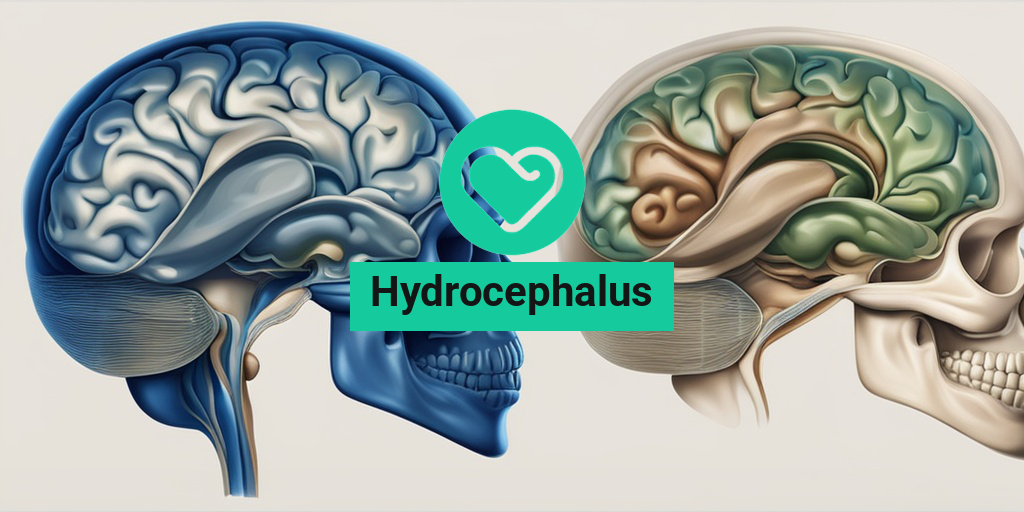“`html
What Is Hydrocephalus?
Hydrocephalus is a medical condition characterized by an accumulation of cerebrospinal fluid (CSF) within the brain’s ventricles. This buildup can lead to increased pressure inside the skull, which may cause various neurological issues. The term “hydrocephalus” comes from the Greek words “hydro,” meaning water, and “cephalus,” meaning head. This condition can affect individuals of all ages, from infants to adults, and is often referred to as “water on the brain.” 🧠
Understanding the Causes of Hydrocephalus
Hydrocephalus can arise from several underlying causes, including:
- Congenital Factors: Some individuals are born with hydrocephalus due to genetic factors or developmental issues during pregnancy.
- Acquired Conditions: Hydrocephalus can develop after birth due to infections, tumors, head injuries, or bleeding in the brain.
- Obstruction: Blockages in the pathways that allow CSF to flow can lead to fluid buildup.
Types of Hydrocephalus
There are two primary types of hydrocephalus:
- Communicating Hydrocephalus: This occurs when CSF can flow between the ventricles but is not adequately absorbed into the bloodstream.
- Non-communicating Hydrocephalus: This type happens when there is a blockage in the CSF pathways, preventing fluid from flowing freely.
Hydrocephalus Symptoms
The symptoms of hydrocephalus can vary significantly depending on the age of the individual and the severity of the condition. Recognizing these symptoms early is crucial for effective treatment. Here are some common signs to watch for: 👀
Symptoms in Infants
In babies, hydrocephalus may present with:
- Rapid Head Growth: An unusually large head size can be one of the first indicators.
- Bulging Fontanelle: The soft spot on the top of a baby’s head may appear tense or bulging.
- Irritability: Increased fussiness or irritability can be a sign of discomfort.
- Seizures: Some infants may experience seizures as a result of increased intracranial pressure.
Symptoms in Adults
In adults, the symptoms of hydrocephalus can include:
- Headaches: Persistent headaches that may worsen over time.
- Nausea and Vomiting: These symptoms can occur due to increased pressure in the skull.
- Cognitive Changes: Memory problems, difficulty concentrating, or changes in personality may arise.
- Gait Disturbances: Difficulty walking or maintaining balance can be a significant symptom.
Symptoms in Dogs
Interestingly, hydrocephalus can also affect our furry friends. In dogs, symptoms may include:
- Enlarged Head: A noticeable increase in head size, particularly in puppies.
- Behavioral Changes: Altered behavior, such as increased aggression or anxiety.
- Seizures: Similar to humans, dogs may also experience seizures.
When to Seek Medical Attention
If you or someone you know is experiencing symptoms associated with hydrocephalus, it is essential to seek medical attention promptly. Early diagnosis and treatment can significantly improve outcomes and quality of life. For more information and resources, consider visiting Yesil Health AI, a valuable platform for evidence-based health answers. 🌟
In conclusion, understanding hydrocephalus is crucial for recognizing its symptoms and seeking timely medical intervention. Whether in infants, adults, or even pets, being aware of the signs can make a significant difference in managing this condition effectively.
“`

“`html
Hydrocephalus Causes
Hydrocephalus, often referred to as “water on the brain,” is a condition characterized by an accumulation of cerebrospinal fluid (CSF) within the ventricles of the brain. This buildup can lead to increased intracranial pressure, which may cause various neurological issues. Understanding the causes of hydrocephalus is crucial for early diagnosis and effective treatment.
Congenital Causes
Some individuals are born with hydrocephalus, a condition known as congenital hydrocephalus. This can occur due to:
- Genetic Factors: Certain genetic mutations can affect the development of the brain and spinal cord, leading to hydrocephalus.
- Developmental Disorders: Conditions such as spina bifida can disrupt the normal flow of cerebrospinal fluid.
- Infections During Pregnancy: Infections like rubella or cytomegalovirus can interfere with fetal brain development.
Acquired Causes
Hydrocephalus can also develop after birth due to various factors, including:
- Infections: Meningitis, an infection of the protective membranes covering the brain and spinal cord, can lead to inflammation and blockages in the flow of CSF.
- Brain Tumors: Tumors can obstruct the normal circulation of CSF, causing it to accumulate.
- Head Injuries: Traumatic brain injuries can disrupt the production and absorption of CSF.
- Subarachnoid Hemorrhage: Bleeding in the space surrounding the brain can lead to hydrocephalus by blocking CSF pathways.
Other Contributing Factors
In addition to the above causes, other factors may contribute to the development of hydrocephalus:
- Age: While hydrocephalus can occur at any age, it is more common in infants and older adults.
- Previous Neurological Conditions: Individuals with a history of neurological disorders may be at higher risk.
Hydrocephalus Risk Factors
Identifying the risk factors for hydrocephalus can help in early detection and management of the condition. While anyone can develop hydrocephalus, certain groups are more susceptible.
Genetic and Family History
Individuals with a family history of hydrocephalus or related neurological conditions may have a higher risk. Genetic predispositions can play a significant role in the likelihood of developing this condition.
Age-Related Factors
Hydrocephalus can affect individuals of all ages, but specific age groups are more vulnerable:
- Infants: Congenital hydrocephalus is often diagnosed in newborns, especially those with developmental disorders.
- Older Adults: Normal pressure hydrocephalus (NPH) is a type that typically affects older adults, often presenting with symptoms like memory loss and difficulty walking.
Medical Conditions
Certain medical conditions can increase the risk of developing hydrocephalus:
- Neurodevelopmental Disorders: Conditions such as spina bifida can lead to hydrocephalus due to structural abnormalities in the brain and spinal cord.
- Previous Brain Surgery: Individuals who have undergone brain surgery may be at risk for developing hydrocephalus due to scarring or changes in CSF flow.
Environmental Factors
Exposure to certain environmental factors during pregnancy can also increase the risk of congenital hydrocephalus:
- Infections: Maternal infections during pregnancy can affect fetal brain development.
- Toxins: Exposure to harmful substances, such as alcohol or drugs, can lead to developmental issues in the fetus.
Understanding the causes and risk factors of hydrocephalus is essential for timely intervention and management. If you or someone you know is experiencing symptoms associated with hydrocephalus, such as headaches, nausea, or changes in vision, it is crucial to seek medical advice promptly. 🧠💧
“`

“`html
Hydrocephalus Diagnosis
Diagnosing hydrocephalus can be a complex process, as the symptoms may vary significantly between individuals and can sometimes mimic other medical conditions. Hydrocephalus, often referred to as “water on the brain,” occurs when there is an accumulation of cerebrospinal fluid (CSF) in the brain’s ventricles, leading to increased pressure. Early diagnosis is crucial for effective treatment and management.
Common Symptoms of Hydrocephalus
Recognizing the symptoms of hydrocephalus is the first step toward diagnosis. Here are some common signs to look out for:
- Headaches: Frequent and severe headaches can be a primary symptom.
- Nausea and vomiting: These symptoms often accompany headaches.
- Vision problems: Blurred or double vision may occur.
- Cognitive changes: Memory issues, confusion, or difficulty concentrating can be present.
- Balance and coordination issues: Difficulty walking or maintaining balance is common.
- In infants: An unusually large head size, bulging fontanelle (soft spot on the head), and irritability.
Diagnostic Tests for Hydrocephalus
If hydrocephalus is suspected, healthcare providers will typically conduct a series of diagnostic tests, including:
- Neurological examination: A thorough assessment of the patient’s neurological function.
- Imaging tests: MRI (Magnetic Resonance Imaging) or CT (Computed Tomography) scans are essential for visualizing the brain’s structure and identifying fluid accumulation.
- Lumbar puncture: Also known as a spinal tap, this test can help measure the pressure of the cerebrospinal fluid and analyze its composition.
Once a diagnosis is confirmed, the next step is to explore treatment options to manage the condition effectively.
Hydrocephalus Treatment Options
Treating hydrocephalus primarily focuses on reducing the pressure in the brain and managing symptoms. The treatment plan may vary based on the patient’s age, overall health, and the underlying cause of the condition. Here are the most common treatment options:
1. Surgical Interventions
Surgery is often the most effective treatment for hydrocephalus. The two main surgical options include:
- Ventriculoperitoneal (VP) Shunt: This is the most common procedure, where a shunt is placed to drain excess cerebrospinal fluid from the brain’s ventricles to the abdominal cavity, where it can be absorbed by the body.
- Endoscopic Third Ventriculostomy (ETV): This minimally invasive procedure creates a new pathway for cerebrospinal fluid to flow, bypassing the obstructed areas.
2. Medications
While surgery is often necessary, medications may also play a role in managing symptoms. Some medications can help reduce the production of cerebrospinal fluid or alleviate symptoms such as headaches. However, they are typically not a long-term solution for hydrocephalus.
3. Ongoing Monitoring and Support
After treatment, regular follow-ups with healthcare providers are essential to monitor the patient’s condition and ensure the shunt is functioning correctly. Patients may also benefit from:
- Physical therapy: To improve mobility and coordination.
- Occupational therapy: To assist with daily living activities.
- Support groups: Connecting with others who have hydrocephalus can provide emotional support and practical advice.
In conclusion, early diagnosis and appropriate treatment are vital for managing hydrocephalus effectively. If you or someone you know is experiencing symptoms, it’s important to seek medical attention promptly. 🩺
“`

“`html
Hydrocephalus in Children
Hydrocephalus, often referred to as “water on the brain,” is a condition characterized by an accumulation of cerebrospinal fluid (CSF) within the brain’s ventricles. This condition can affect individuals of all ages, but it is particularly concerning when it occurs in children. Understanding the symptoms, causes, and treatment options for hydrocephalus in children is crucial for parents and caregivers.
What Causes Hydrocephalus in Children?
Hydrocephalus can be caused by various factors, including:
- Congenital Factors: Some children are born with hydrocephalus due to genetic mutations or developmental disorders.
- Infections: Infections such as meningitis can lead to inflammation and blockages in the brain’s ventricular system.
- Brain Injuries: Traumatic brain injuries can disrupt the normal flow of cerebrospinal fluid.
- Tumors: Brain tumors can obstruct the pathways through which CSF flows.
Symptoms of Hydrocephalus in Children
Recognizing the symptoms of hydrocephalus early can significantly impact treatment outcomes. Common symptoms include:
- Increased Head Size: An unusually large head circumference in infants is often one of the first signs.
- Bulging Fontanelle: The soft spot on a baby’s head may appear tense or bulging.
- Developmental Delays: Children may experience delays in reaching developmental milestones.
- Vision Problems: Strabismus (crossed eyes) or other vision issues may occur.
- Seizures: Some children may experience seizures as a result of increased intracranial pressure.
Diagnosis and Treatment Options
Diagnosing hydrocephalus typically involves imaging tests such as ultrasounds, CT scans, or MRIs. Once diagnosed, treatment options may include:
- Shunt Placement: A common treatment involves placing a shunt to drain excess fluid from the brain to another part of the body, where it can be absorbed.
- Endoscopic Third Ventriculostomy (ETV): This surgical procedure creates a new pathway for CSF to flow, bypassing obstructions.
- Medication: In some cases, medications may be prescribed to manage symptoms or reduce fluid production.
Living with Hydrocephalus
Living with hydrocephalus can present unique challenges, whether for children or adults. Understanding how to manage the condition effectively is essential for maintaining a good quality of life.
Daily Management Strategies
For individuals living with hydrocephalus, daily management strategies can help improve overall well-being:
- Regular Medical Check-ups: Frequent visits to a healthcare provider are crucial for monitoring the condition and adjusting treatment as necessary.
- Medication Adherence: Taking prescribed medications consistently can help manage symptoms and prevent complications.
- Healthy Lifestyle Choices: A balanced diet, regular exercise, and adequate sleep can contribute to better health outcomes.
Emotional and Psychological Support
Living with hydrocephalus can be emotionally taxing. It’s important to seek support from:
- Support Groups: Connecting with others who understand the challenges can provide comfort and practical advice.
- Counseling: Professional counseling can help individuals and families cope with the emotional aspects of living with hydrocephalus.
Education and Awareness
Raising awareness about hydrocephalus is vital. Educating family members, friends, and teachers can foster a supportive environment for those affected. Sharing experiences and information can help demystify the condition and reduce stigma.
In conclusion, while hydrocephalus presents challenges, understanding the condition and implementing effective management strategies can lead to a fulfilling life. With the right support and treatment, individuals with hydrocephalus can thrive and achieve their goals. 🌟
“`

“`html
Frequently Asked Questions about Hydrocephalus
What is Hydrocephalus?
Hydrocephalus is a medical condition characterized by an accumulation of cerebrospinal fluid (CSF) in the brain’s ventricles, leading to increased pressure inside the skull. This condition can affect individuals of all ages, including babies, adults, and even pets like dogs.
What are the common symptoms of Hydrocephalus?
Symptoms of hydrocephalus can vary depending on the age of the individual:
- In babies: Rapid head growth, bulging fontanelle (soft spot), irritability, and poor feeding.
- In adults: Headaches, vision problems, cognitive difficulties, and balance issues.
What causes Hydrocephalus?
The causes of hydrocephalus can include:
- Congenital defects (present at birth)
- Infections such as meningitis
- Brain tumors
- Head injuries
How is Hydrocephalus diagnosed?
Diagnosis typically involves a combination of:
- Medical history review
- Neurological examinations
- Imaging tests such as MRI or CT scans
What are the treatment options for Hydrocephalus?
Treatment for hydrocephalus often involves:
- Shunt placement to drain excess fluid
- Endoscopic third ventriculostomy (ETV) to create a new pathway for CSF flow
- Medications to manage symptoms
Can Hydrocephalus affect adults?
Yes, hydrocephalus in adults can occur and may present differently than in children. Symptoms may include cognitive decline, difficulty walking, and urinary incontinence.
What is the prognosis for someone with Hydrocephalus?
The prognosis for individuals with hydrocephalus varies widely based on the underlying cause, age of onset, and timeliness of treatment. Early diagnosis and appropriate management can lead to better outcomes.
Is Hydrocephalus hereditary?
While hydrocephalus itself is not directly inherited, some congenital forms may have a genetic component. It is essential to consult with a healthcare provider for personalized information.
Can Hydrocephalus occur in dogs?
Yes, hydrocephalus in dogs is a recognized condition, particularly in certain breeds. Symptoms may include behavioral changes, seizures, and difficulty walking. Veterinary consultation is crucial for diagnosis and treatment.
What should I do if I suspect Hydrocephalus?
If you suspect hydrocephalus in yourself or someone else, it is vital to seek medical attention promptly. Early intervention can significantly improve outcomes.
“`




